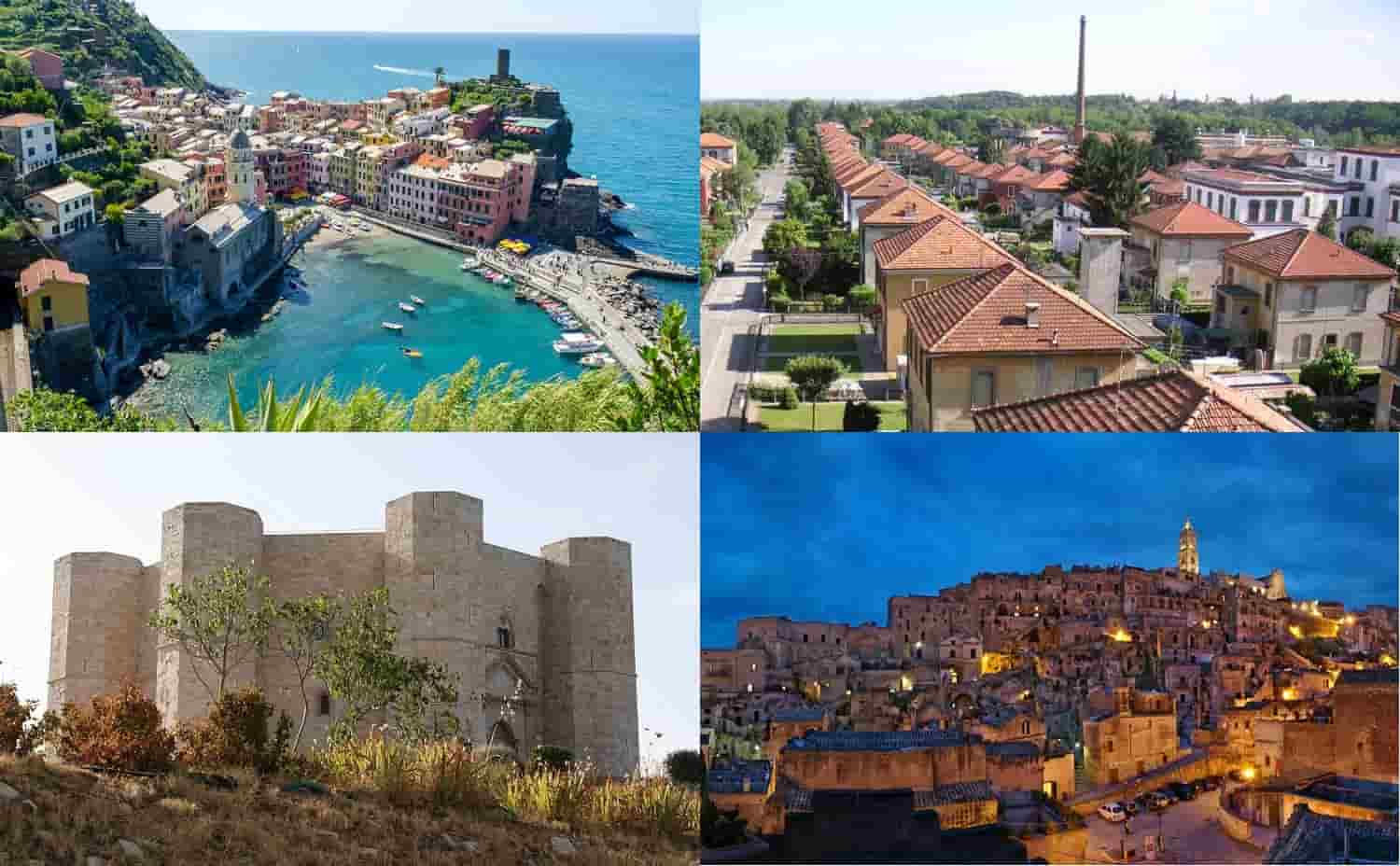
Unesco Sites in Italy
Italy, with 60 UNESCO sites, is the country with the largest number of sites included in the list of world heritage sites: 54 cultural sites, 6 natural, of which 7 are part of transnational sites.
The last Unesco site has been nominated in 2024. But thanks to the richness of the Italian heritage, today Italy already has 30 applications for new registrations.
Here you will find a list of all the Italian UNESCO sites divided by regions. An excellent opportunity to find out what they are and where they are to plan your next trip!
TRENTINO ALTO ADIGE
The Dolomites – Province of Bolzano, Province of Trento in Friuli-Venezia Giulia, Veneto and Trentino-Alto Adige (2009)
Prehistoric pile dwelling sites around the Alps in Friuli-Venezia Giulia, Lombardy, Piedmont, Veneto, Trentino-Alto Adige (2011)
PIEDMONT
Residences of the Royal House of Savoy (1997)
Sacri Monti (Sacred Mountains) of Piedmont and Lombardy (2003)
Vineyard landscapes of Langhe-Roero and Monferrato (2014)
Ivrea, industrial city of the twentieth century – Turin (2018)
LOMBARDY
Rock Drawings in Valcamonica – Brescia (1979)
The Last Supper by Leonardo da Vinci in Church and Dominican Convent of Santa Maria delle Grazie – Milan (1980)
Crespi d’Adda: the industrial settlement – Bergamo (1995)
Sacro Monte (Sacred Mountain) – Varese (2003)
The Rhaetian Railway: in Albula and Bernina landscapes – Sondrio (2008)
Mantua and Sabbioneta (2008)
Monte San Giorgio – Varese (2010)
Prehistoric pile dwelling sites around the Alps in Friuli-Venezia Giulia, Lombardy, Piedmont, Veneto, Trentino-Alto Adige (2011)
Lombards in Italy, places of the power (568-774D.C.) And the monastic complex of San Salvatore – Santa Giulia – Brescia (2011)
Lombards in Italy, places of the power (568-774D.C.): The castrum of Castelseprio – Torba, in the province of Varese (2011)
The Venetian Walls of Bergamo, Peschiera and Palmanova (2017)
VENETO
Venice and its Lagoon (1987)
Vicenza and the Palladian villas of Veneto (1994)
The Padua Botanical Garden – Padua (1997)
Verona (2000)
The Dolomites in Friuli-Venezia Giulia, Veneto and Trentino-Alto Adige (2009)
Prehistoric pile dwelling sites around the Alps in Friuli-Venezia Giulia, Lombardy, Piedmont, Veneto, Trentino-Alto Adige (2011)
Venetian Works of Defence between the 16th and 17th centuries: Stato da Terra – Western Stato da Mar in Friuli-Venezia Giulia, Lombardy, Veneto (2017)
The Prosecco Hills of Conegliano and Valdobbiadene – Treviso (2019)
Padua’s fourteenth-century fresco cycles, Giotto’s Scrovegni Chapel and the frescoes at Palazzo della Ragione – Padua (2021)
LIGURIA
Portovenere (1997)
The Cinque Terre (1997)
The islands of Palmaria, Tino, Tinetto (1997)
Genoa: Le Strade Nuove and the system of the Palazzi dei Rolli (2006)
FRIULI VENEZIA GIULIA
Aquileia: the archaeological area and the Patriarchal Basilica (1998)
The Dolomites in Friuli-Venezia Giulia, Veneto and Trentino-Alto Adige (2009)
Prehistoric pile dwelling sites around the Alps in Friuli-Venezia Giulia, Lombardy, Piedmont, Veneto, Trentino-Alto Adige (2011)
Lombards in Italy, places of the power (568-774 AD): the Lombard temple – Cividale del Friuli (2011)
Palmanova Fortress (2011)
EMILIA ROMAGNA
Ferrara: city of the Renaissance and its Po Delta (1995)
Ravenna: Early Christian Monuments (1996)
Modena: the Cathedral, the Civic Tower and Piazza Grande (1997)
Bologna: the porticoes (2021)
The karst caves in the Northern Appennino mountains in the provinces of Bologna, Reggio Emilia, Rimini, Ravenna (2023)
TUSCANY
Florence: the historic center (1982)
Pienza: the historic center – Siena (1986)
Pisa: the Cathedral square (1987)
San Gimignano: the historic center – Siena (1990)
Siena: the historic center (1995)
Val d’Orcia – Siena (2004)
Medici Villas and Gardens in Tuscany (2013)
Montecatini Terme (2021) – The Great Spa Towns of Europe*
MARCHE
Urbino, the historic center (1998)
UMBRIA
Assisi, the Basilica of San Francesco and Other Franciscan Sites (2000)
Lombards in Italy, places of the power (568-774D.C.): The small temple of Clitunno in Campello (2011)
Lombards in Italy, places of the power (568-774D.C.): The basilica of San Salvatore in Spoleto (2011)
LAZIO
Rome: historic center, (1980)
the Properties of the Holy See in that City Enjoying Extraterritorial Rights and San Paolo Fuori le Mura (1980)
Tivoli: Villa Adriana (1999)
Tivoli: Villa d’Este (2001)
Cerveteri and Tarquinia: the Etruscan necropolis (2004)
Via Appia (2024) one of the main Roman roads, realized in 312 before Christ
ABRUZZO
Ancient and Primeval Beech Forests of the Carpathians and Other Regions of Europe, 13 beech forests in Italy in 6 regions: in Abruzzo, Basilicata, Calabria, Emilia-Romagna, Lazio, Puglia. (2017)
CAMPANIA
Naples: the historic center (1995)
Amalfi: the Amalfi Coast (1997)
Pompeii, Herculaneum and Torre Annunziata: the archaeological areas (1997)
Caserta: the Royal Palace and its park, San Leucio complex and the Aqueduct of Vanvitelli (1997)
Cilento: the National Park and the Vallo di Diano, Paestum, Velia and the Certosa di Padula (1998)
The Lombards in Italy, places of the Power (568-774D.C.): The church of Santa Sofia – Benevento (2011)
BASILICATA
The Sassi of Matera and the park of the rupestrian churches (1993)
PUGLIA
Alberobello: the Trulli – Bari (1996)
Castel Del Monte – Andria (1996)
The Lombards in Italy, places of the power (568-774D.C.) (2011)
The Sanctuary of Saint Michael the Archangel in Monte Sant ‘Angelo – Foggia (2011)
SICILY
Agrigento: the archaeological area (1997)
Piazza Armerina: the Roman Villa del Casale – Enna (1997)
Aeolian Islands: Lipari, Vulcano, Salina, Stromboli, Filicudi, Alicudi and Panarea (2000)
Val di Noto: the Late Baroque towns – Syracuse (2002)
Syracuse and the Rocky Necropolis of Pantalica (2006)
Mount Etna – Catania (2013)
Arab-Norman Palermo and the Cathedrals of Cefalù and Monreale (2015)
SARDINIA
Barumini: the Nuragic village “Su Nuraxi” – South Sardinia (1997)
Cover photo from top to bottom, from left to right: Cinque Terre, Crespi d’Adda workers’ village, Castel del Monte, Sassi di Matera.
